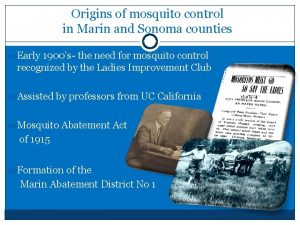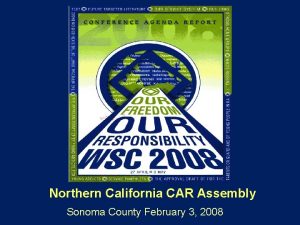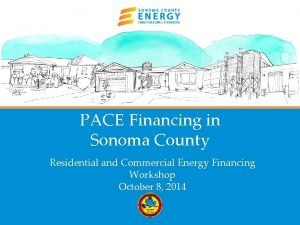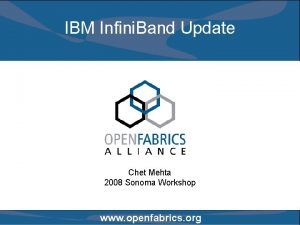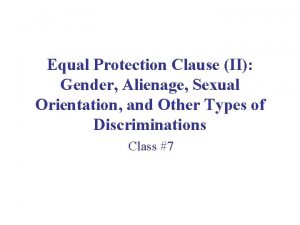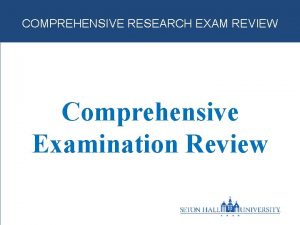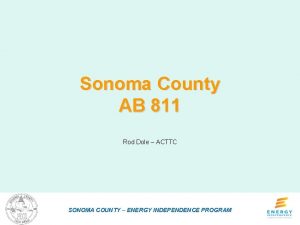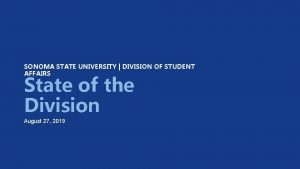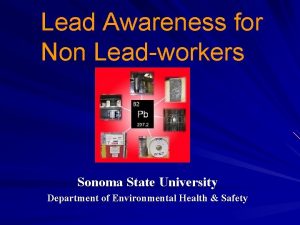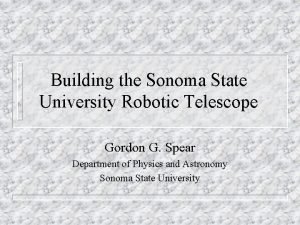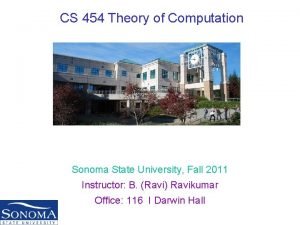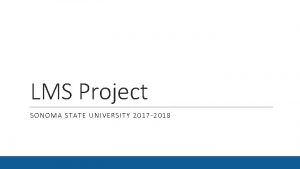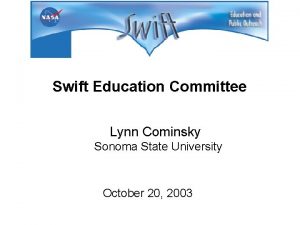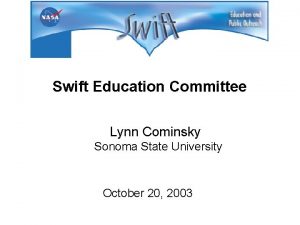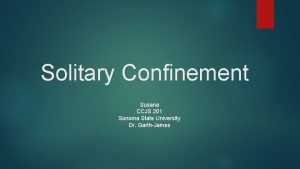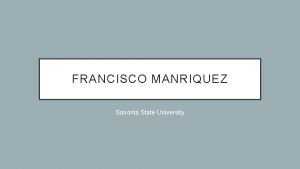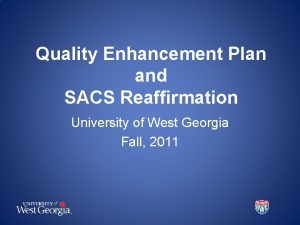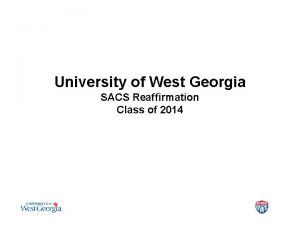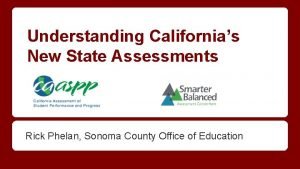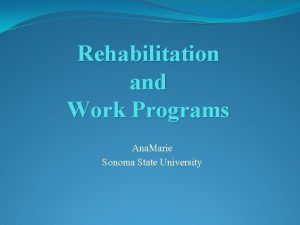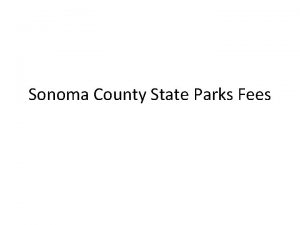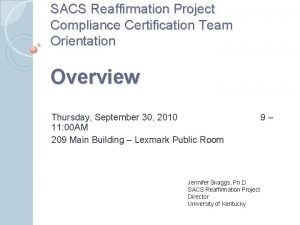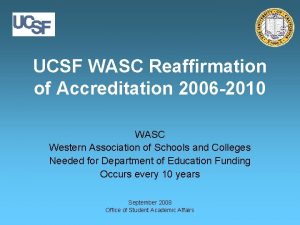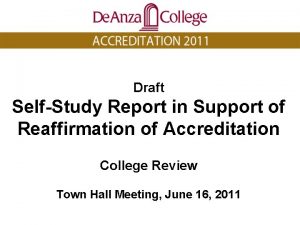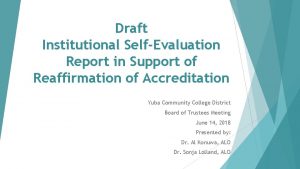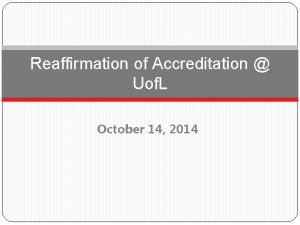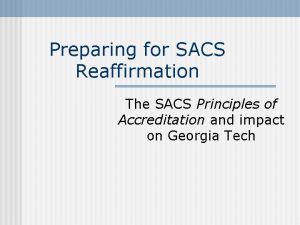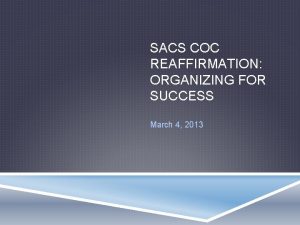SONOMA STATE UNIVERSITY Comprehensive Review for Reaffirmation of





































- Slides: 37

SONOMA STATE UNIVERSITY Comprehensive Review for Reaffirmation of Accreditation Presentation to Campus Forum October 21, 2015 Christopher Oberg, Vice President/COO WASC Senior College and University Commission

Higher Education Today Three Key Statistics 5. 2 – 7. 0 thousand institutions 20. 4 million students $600 billion revenues = 3. 3% GDP ($150 billion in financial aid) 2

Higher Education Today Why is accreditation in the news so much there days? 3

Higher Education Today Five major perceptions about and conditions of U. S. higher education 4

Higher Education Today 1. Perceived low graduation rates (Not enough product) 5

Higher Education Today 1. Perceived low graduation rates (Not enough product) 2. High tuition and student debt (Product costs too much) 6

Higher Education Today 1. Perceived low graduation rates (Not enough product) 2. High tuition and student debt (Product costs too much) 3. Employer dissatisfaction with quality of graduates (Product is of poor quality) 7

Higher Education Today 1. Perceived low graduation rates (Not enough product) 2. High tuition and student debt (Product costs too much) 3. Employer dissatisfaction with quality of graduates (Product is of poor quality) 4. Accelerated expansion of online learning (Means of production vary) 8

Higher Education Today 1. Perceived low graduation rates (Not enough product) 2. High tuition and student debt (Product costs too much) 3. Employer dissatisfaction with quality of graduates (Product is of poor quality) 4. Accelerated expansion of online learning (Means of production vary) 5. Growth of the for- profit sector (Models of production vary) 9

“WSCUC” “WASC Senior College and University Commission” “WASC” is now a brand, not an acronym 10

Your WSCUC Staff Liaison • • • Counselor Collaborator Interpreter Non-contributing Editor Trainer AND lastly Compliance Guide 11

Reaffirmation Overview My experience as a WSCUC liaison: If you are doing what you say you want to be doing, and you can provide evidence – you will be in compliance 12

Reaffirmation Overview • Process occurs once every 8 – 10 years and is the cornerstone of quality assurance in American higher education • Only nation that uses voluntary, non -governmental peer review as its primary quality assurance vehicle 13

Reaffirmation Overview • Process: • One report • One visit • Institutional Report • Nine Components 14

Reaffirmation Process • Offsite Review (OSR) • Team only in WSCUC Office • One day with video conference • Accreditation Visit (6 months later) • 2. 5 day visit on campus • Focused, not comprehensive 15

Institutional Report – The Core Commitments 1. Student Learning and Success 2. Quality and Improvement 3. Integrity, Sustainability, and Accountability 16

Institutional Report IT’S YOUR STORY And you should all contribute 17

Institutional Report IT’S YOUR STORY Write it in a way you would want to read it 18

Institutional Report IT’S YOUR STORY Be evidential (but more is not better) 19

Institutional Report IT’S YOUR STORY Think documentary - not “report” 20

Institutional Report • Estimable Qualities: • Candid and frank • Brief and succinct • Clear and precise • Simple and direct 21

Institutional Report – The WSCUC Way The Commission says “What” needs to be done – it doesn’t say “How” 22

Institutional Report – The WSCUC Way: DMAA • Define • Measure (Assess) • Analyze (Plan) • Act (And repeat……. ) 23

Institutional Report – Component 1 Introduction • Institutional context: history, values, uniqueness, changes, public good contribution; process of preparing Institutional Report • Response to previous Commission actions 24

Institutional Report – Component 2 Compliance • Review under the WSCUC Standards (4 compliance forms) • Inventory of Educational Effectiveness Indicators (IEEI) • Both included in Exhibits 25

Institutional Report – Component 3 Meaning, Quality, Integrity of Degree • What is the end or purpose or significance of the degree experience? • What is your distinguishing way of accomplishing student learning? 26

Institutional Report – Component 4 Student Learning (Outcomes): • • • What do your students learn in GE? The major? Elsewhere? Where are student outcomes specified? How are they documented? (Hint: CFR 2. 4) How well have your students learned (assessment)? 27

Institutional Report – Component 4 • Core Competencies: 1. Writing; 2. Oral communication; 3. Quantitative reasoning; 4. Critical thinking; 5. Information literacy • How well do students perform at or near graduation? (Not necessarily to be measured in the major) 28

Institutional Report – Component 5 Student Success • How does the institution define student success given its mission, values, programs and the students it serves? • How does the institution promote student success? • How well are students doing in meeting the institution’s definition of student success? 29

Institutional Report – Component 6 Quality Assurance and Improvement • Program review is the cornerstone: Be simple, direct, periodic, inclusive (“finished” but not “complete”) • Assessment is the means – it’s an annual engagement • Data and evidence are the assessment mill’s grist 30

Institutional Report – Component 7 Finance and Future • Financial: viability and alignment (no additional data required) • Changing ecology of higher education: Process, not prognostication 31

Institutional Report – Component 8 Optional essay • What, you really want to write even more? !? [Alert WASC liaison if chosen, so an appropriate team can be selected] 32

Institutional Report – Component 9 Conclusion and Reflection A Meta Perspective • What did you learn in the process? • What will you do with what you learned? • How does your “story” end? 33

WSCUC Commission: Key Emphases • Preserving voluntary peer review as the mode of quality assurance • Assuring that the accreditation process adds value • Outcomes, outcomes 34

WSCUC Commission: Key Emphases • • • Creating comprehensive understandings of the Meaning, Quality, Integrity of Degree Assuring promotion of student, faculty, and staff diversity Preserving diversity among institutional types 35

WSCUC Commission: Key Emphases • Maintaining institutional autonomy (no bright lines) • Enhancing methods of retention • Creating alternative and complementary measures of graduation rates (Graduation Rate Dashboard) 36

Contact Information Christopher Oberg coberg@wascsenior. org 909. 730. 7933 (cell) 510. 995. 3175 (office direct) 37
 Sonoma county vector control
Sonoma county vector control Northern sonoma county air pollution control district
Northern sonoma county air pollution control district Sonoma county na meetings
Sonoma county na meetings Sonoma county energy independence program
Sonoma county energy independence program Chet mehta
Chet mehta Intermediate scrutiny
Intermediate scrutiny Formuö
Formuö Typiska drag för en novell
Typiska drag för en novell Nationell inriktning för artificiell intelligens
Nationell inriktning för artificiell intelligens Returpilarna
Returpilarna Varför kallas perioden 1918-1939 för mellankrigstiden
Varför kallas perioden 1918-1939 för mellankrigstiden En lathund för arbete med kontinuitetshantering
En lathund för arbete med kontinuitetshantering Underlag för särskild löneskatt på pensionskostnader
Underlag för särskild löneskatt på pensionskostnader Personlig tidbok fylla i
Personlig tidbok fylla i Anatomi organ reproduksi
Anatomi organ reproduksi Förklara densitet för barn
Förklara densitet för barn Datorkunskap för nybörjare
Datorkunskap för nybörjare Stig kerman
Stig kerman Debatt artikel mall
Debatt artikel mall Autokratiskt ledarskap
Autokratiskt ledarskap Nyckelkompetenser för livslångt lärande
Nyckelkompetenser för livslångt lärande Påbyggnader för flakfordon
Påbyggnader för flakfordon Formel för lufttryck
Formel för lufttryck Svenskt ramverk för digital samverkan
Svenskt ramverk för digital samverkan Bo bergman jag fryser om dina händer
Bo bergman jag fryser om dina händer Presentera för publik crossboss
Presentera för publik crossboss Argument för teckenspråk som minoritetsspråk
Argument för teckenspråk som minoritetsspråk Kanaans land
Kanaans land Klassificeringsstruktur för kommunala verksamheter
Klassificeringsstruktur för kommunala verksamheter Fimbrietratt
Fimbrietratt Bästa kameran för astrofoto
Bästa kameran för astrofoto Cks
Cks Programskede byggprocessen
Programskede byggprocessen Mat för idrottare
Mat för idrottare Verktyg för automatisering av utbetalningar
Verktyg för automatisering av utbetalningar Rutin för avvikelsehantering
Rutin för avvikelsehantering Smärtskolan kunskap för livet
Smärtskolan kunskap för livet Ministerstyre för och nackdelar
Ministerstyre för och nackdelar
